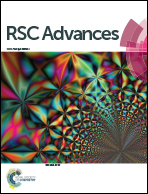Magnetic ion oxidation state dependent magnetoelectric coupling strength in Fe doped BCT ceramics
Abstract
Polycrystalline samples of Ba0.96Ca0.04Ti0.91Fe0.09O3 were prepared using a conventional solid state reaction route with different Fe starting precursors (Fe2O3, Fe3O4). The Rietveld refined XRD data confirmed the phase purity and tetragonal crystal structure of both the samples. The average grain size measured using SEM was ≈0.40 μm in both the samples. XPS analysis confirmed the presence of only Fe2+ and both Fe2+/Fe3+ in Fe2O3 and Fe3O4 doped BCT samples. The Pr and Mr values have been measured to be 1.34 μC cm−2, 2.88 μC cm−2 and 0.0015 emu g−1 and 0.135 emu g−1 in Fe2O3 and Fe3O4 doped BCT samples, respectively. The Fe3O4 doped samples exhibit much better M-E coupling (≈22%) as compared to Fe2O3 (≈7%) doped BCT samples. The results obtained hence suggest that Fe3O4 doping in BCT is better suited for multiferroic applications.



 Please wait while we load your content...
Please wait while we load your content...